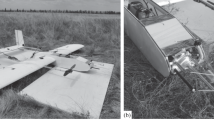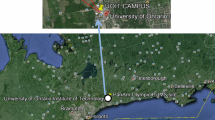Abstract
For the first time, unmanned aerial system measurements collected by the small unmanned meteorological observer (SUMO) are used to evaluate atmospheric boundary layer (ABL) parameterization schemes embedded in the Advanced Weather Research and Forecasting model (AR-WRF). Observation sites were located in the vicinity of the almost idealized shaped mountain Hofsjökull, Central Iceland. SUMO profiles provided temperature, relative humidity and wind data to maximum heights of 3 km above ground. Two cases are investigated, one with calm wind conditions and development of a convective ABL and one with moderate winds and gravity waves over Hofsjökull. For the high-resolution simulation with AR-WRF, three two-way nested domains are chosen with a grid size of 9, 3 and 1 km. During its first meteorological test, SUMO has proved its great value for the investigation of the diurnal evolution of the ABL and the identification of mesoscale features residing above the ABL, such as subsidence.














Similar content being viewed by others
References
Ágústsson H, Ólafsson H (2007) Simulating a severe windstorm in complex terrain. Meteorol Z 16(1):111–122
Ágústsson H, Cuxart J, Mira A, Ólafsson H (2007) Observations and simulation of katabatic flows during a heatwave in Iceland. Meteorol Z 16(1):99–110
Ahmadov R, Gerbig C, Kretschmer R, Koerner S, Neininger B, Dolman A, Sarrat C (2007) Mesoscale covariance of transport and CO2 fluxes: Evidence from observations and simulations using the WRF-VPRM coupled atmosphere–biosphere model. J Geophys Res Atmos 112(D22):14
Dudhia J (1989) Numerical study of convection observed during the winter monsoon experiment using a mesoscale two-dimensional model. J Atmos Sci 46(20):3077–3107
Egger J, Bajrachaya S, Heinrich R, Kolb P, Lämmlein S, Mech M, Reuder J, Schäper W, Shakya P, Schween J, Wendt H (2002) Diurnal winds in the Himalayan Kali Gandaki Valley. Part III: remotely piloted aircraft soundings. Mon Weather Rev 130:2042–2058
Garratt J (1994) The atmospheric boundary layer. Cambridge University Press, Cambridge
Hong S, Kim S (2007) Stable boundary layer mixing in a vertical diffusion scheme. The Korea Meteorological Society, Fall conference, Seoul, Korea, Oct 25–26
Hong S, Pan H (1996) Nonlocal boundary layer vertical diffusion in a medium-range forecast model. Mon Weather Rev 124(10):2322–2339
Hong S, Dudhia J, Chen S (2004) A revised approach to ice microphysical processes for the bulk parameterization of clouds and precipitation. Mon Weather Rev 132(1):103–120
Hong S, Noh Y, Dudhia J (2006) A new vertical diffusion package with an explicit treatment of entrainment processes. Mon Weather Rev 134(9):2318–2341
Holland G, Webster P, Curry J, Tyrell G, Gauntlett D, Brett G, Becker J, Hoag R, Vaglienti W (2001) The Aerosonde robotic aircraft: a new paradigm for environmental observations. Bull Am Meteorol Soc 82(5):889–901
Janjic Z (1990) The step-mountain coordinate: physical package. Mon Weather Rev 118(7):1429–1443
Janjic Z (1996) The surface layer in the NCEP eta model. 11th conference on numerical weather prediction, American Meteorological Society, pp 354–355
Janjic Z (2002) Nonsingular implementation of the Mellor-Yamada Level 2.5 Scheme in the NCEP meso models. NCEP Office Note No. 437, 61 p
Jonassen M (2008) The small unmanned meteorological observer (SUMO)—characterization and test of a new measurement system for atmospheric boundary layer research. Master’s thesis, Geophysical Institute, University of Bergen
Konrad T, Hill M, Rowland J, Meyer J (1970) A small, radio-controlled aircraft as a platform for meteorological sensors. Appl Phys Lab Tech Digest 10:11–19
Ma S, Chen H, Wang G, Pan Y, Li Q (2004) A miniature robotic plane meteorological sounding system. Adv Atmos Sci 21(6):890–896
Mlawer E, Taubman S, Brown P, Iacono M, Clough S (1997) Radiative transfer for inhomogeneous atmosphere: RRTM, a validated correlated-k model for the longwave. J Geophys Res 102(D14):16,663–16,682
Pleim J (2007) A combined local and nonlocal closure model for the atmospheric boundary layer. Part I: model description and testing. J Appl Meteorol Climatol 46(9):1383–1395
Reuder J, Ablinger M, Águstsson H, Brisset P, Brynjólfsson S, Garhammer M, Johannesson T, Jonassen M, Kühnel R, Lämmlein S, de Lange T, Lindenberg C, Malardel S, Mayer S, Müller M, Ólafsson H, Rögnvaldsson O, Schäper W, Spengler T, Zängl G, Egger J (2009a) FLOHOF 2007: an overview of the mesoscale meteorological field campaign at Hofsjökull, Central Iceland. Meteorol Atmos Phys (this issue)
Reuder J, Brisset P, Jonassen M, Müller M, Mayer S (2009b) The small unmanned meteorological observer SUMO: a new tool for atmospheric boundary layer research. Meteorol Z 18(2):141–147
Sandvik A, Furevik B (2002) Case study of a coastal jet at Spitsbergen—comparison of SAR and model estimated wind. Mon Weather Rev 130:1040–1051
Skamarock W, Klemp J, Dudhia J, Gill D, Barker D, Wang W, Powers J (2005) A description of the advanced research WRF version 2. NCAR Tech Notes 468+ STR
Spiess T, Bange J, Buschmann M, Vörsmann P (2007) First application of the meteorological Mini-UAV M2AV. Meteorol Z 16(2):159–169
Steeneveld G, Mauritsen T, de Bruijn E, Vilà-Guerau de Arellano J, Svensson G, Holtslag A (2008) Evaluation of limited-area models for the representation of the diurnal cycle and contrasting nights in CASES-99. J Appl Meteorol Climatol 47(3):869–887
Stensrud D (2007) Parameterization schemes: keys to understanding numerical weather prediction models. Cambridge University Press, Cambridge
Stull R (1988) An introduction to boundary layer meteorology. Kluwer Academic Publishers, Dordrecht
Teixeira J, Stevens B, Bretherton C, Cederwall R, Doyle J, Golaz J, Holtslag A, Klein S, Lundquist J, Randall D, Siebesma A, Soares P (2008) Parameterization of the atmospheric boundary layer: a view from just above the inversion. Bull Am Meteorol Soc 89(4):453–458
Troen I, Mahrt L (1986) A simple model of the atmospheric boundary layer; sensitivity to surface evaporation. Bound Layer Meteorol 37:129–148
Acknowledgments
Supercomputing resources, on a Cray XT4 computer at Parallab at the University of Bergen, have been made available by the Norwegian Research Council. The observational data used in this study were collected as part of the field campaign FLOHOF. The authors wish to acknowledge all participants of FLOHOF, especially Martin Müller, Pascal Brisset and Christian Lindenberg. The improved landuse data set has been kindly provided by Reiknistofa i veðurfræði (Icelandic Institute for Meteorological Research).
Author information
Authors and Affiliations
Corresponding author
Rights and permissions
About this article
Cite this article
Mayer, S., Sandvik, A., Jonassen, M.O. et al. Atmospheric profiling with the UAS SUMO: a new perspective for the evaluation of fine-scale atmospheric models. Meteorol Atmos Phys 116, 15–26 (2012). https://doi.org/10.1007/s00703-010-0063-2
Received:
Accepted:
Published:
Issue Date:
DOI: https://doi.org/10.1007/s00703-010-0063-2




